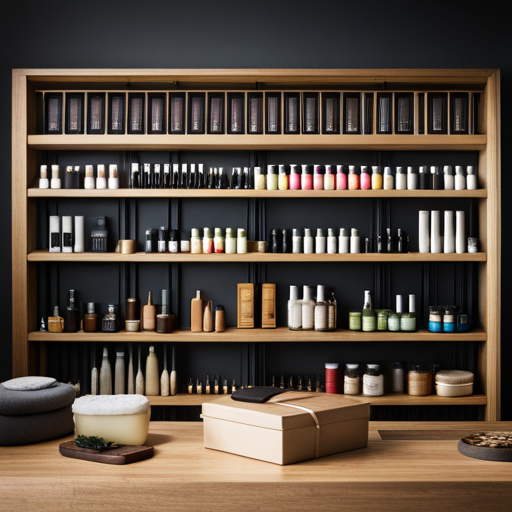How to Choose the Right Shampoo and Conditioner

Did you know that the average person spends over $800 a year on hair care products? With so many options on the market, it can be overwhelming to choose the right shampoo and conditioner for your specific needs.
In this article, we will explore the key factors to consider when selecting the perfect hair care products. From understanding your hair type to deciphering product labels, we will guide you through the process of finding the ideal shampoo and conditioner for healthy, beautiful hair.
Understanding Your Hair Type
Understanding your hair type is crucial for selecting the most suitable shampoo and conditioner. Hair maintenance varies depending on whether you have straight, wavy, curly, or coily hair.
Straight hair tends to get oily quickly and can appear flat, so it benefits from volumizing and oil-controlling shampoos.
For wavy hair, a hydrating shampoo and conditioner are ideal to enhance natural waves and reduce frizz.
Curly hair requires extra moisture, so look for products specifically designed for curls to keep them defined and bouncy.
Coily hair is prone to dryness and requires rich, creamy shampoos and conditioners with a focus on moisture retention and detangling.
When selecting products, it’s essential to consider your scalp condition as well. Those with dry scalp may benefit from moisturizing shampoos, while individuals with oily scalp may require clarifying shampoos to remove excess oil and buildup.
Always choose products free from sulfates, parabens, and silicones, as these can strip the hair of natural oils and cause further damage.
Understanding your hair type and its unique needs will guide you in making the right product recommendations for a healthy, lustrous mane.
Identifying Your Hair Concerns
Before selecting the right shampoo and conditioner, it’s crucial to identify your specific hair concerns.
This can include issues such as dryness, frizz, damage, or scalp conditions.
Hair Type Assessment
To properly select the right shampoo and conditioner for your hair, it is essential to assess your hair type and identify specific concerns.
When assessing your hair type, consider the following factors:
-
Hair Texture: Determine if your hair is fine, medium, or coarse in texture. This will help you choose products that provide the right level of nourishment without weighing your hair down or leaving it greasy.
-
Moisture Levels: Assess whether your hair tends to be dry, oily, or normal. Understanding your hair’s moisture levels will guide you in selecting products that hydrate and balance your hair without over-moisturizing or stripping it of natural oils.
-
Scalp Health: Evaluate the condition of your scalp to address any specific concerns such as dandruff, sensitivity, or excess oil production.
-
Damage: Identify any damage or specific issues such as split ends, breakage, or color-treated hair that require targeted care and repair.
Targeted Product Selection
After assessing your hair type and specific concerns, it is imperative to identify targeted products that address your hair’s unique needs with precision and effectiveness. When selecting the right shampoo and conditioner, it’s essential to consider product effectiveness and consumer reviews. Professional recommendations and salon consultations can also provide valuable insights into the most suitable products for your hair concerns. Below is a table summarizing some common hair concerns and the recommended ingredients to look for in shampoos and conditioners:
| Hair Concern | Recommended Ingredients |
|---|---|
| Dryness | Argan oil, shea butter |
| Frizz | Coconut oil, keratin |
| Volume | Biotin, rice protein |
| Color-treated | UV filters, vitamin E |
Understanding your specific hair concerns and the ingredients that target those issues is crucial in choosing the right shampoo and conditioner for your hair. Next, let’s explore the importance of reading product labels when making your selection.
Reading Product Labels
Understanding the ingredients is essential when reading product labels for shampoo and conditioner. To make an informed decision, consider the following key points:
-
Understanding pH balance: Look for products that mention pH balance on the label. The ideal pH for shampoo and conditioner is between 4.5 and 5.5, which is close to the natural pH of the hair and scalp. This helps maintain the protective layer of the hair and prevents drying or damage.
-
Avoiding sulfates: Check the label for sulfate-free formulas. Sulfates, such as sodium lauryl sulfate and sodium laureth sulfate, can strip the hair of its natural oils, leading to dryness and irritation, especially for those with sensitive skin or color-treated hair.
-
Identifying key ingredients: Familiarize yourself with common beneficial ingredients like natural oils, vitamins, and proteins. Look for ingredients that cater to your specific hair needs, such as moisturizing oils for dry hair or proteins for strengthening.
-
Checking for allergens: If you have known allergies or sensitivities, carefully read through the ingredient list to avoid any potential allergens that may cause adverse reactions.
Understanding these aspects will help in making well-informed decisions when selecting the right shampoo and conditioner.
Moving forward, let’s explore the importance of avoiding harmful ingredients.
Avoiding Harmful Ingredients
When considering the selection of shampoo and conditioner, it is imperative to be mindful of harmful ingredients that can adversely affect the health and appearance of your hair. Identifying harmful ingredients and being ingredient-aware is crucial for making informed choices. Some common harmful ingredients found in hair care products include sulfates, parabens, and silicones. These substances can strip the hair of its natural oils, cause irritation to the scalp, and create a buildup that weighs the hair down.
To help you make informed decisions, here is a table highlighting some harmful ingredients to watch out for in shampoos and conditioners:
| Harmful Ingredient | Potential Effects | Product Example |
|---|---|---|
| Sulfates | Strips natural oils | Sodium lauryl sulfate |
| Parabens | Hormone disruption | Methylparaben |
| Silicones | Causes buildup | Dimethicone |
Being aware of these harmful ingredients can guide you towards choosing products that promote the health and vitality of your hair. Look for shampoos and conditioners that are free from these harmful substances to maintain luscious, healthy locks.
Selecting the Right Shampoo
When it comes to selecting the right shampoo, it’s essential to consider your hair type. Different shampoos are formulated to address specific needs, such as oily, dry, or color-treated hair.
Additionally, being aware of any ingredient sensitivities can help narrow down the options and ensure that the chosen shampoo is suitable for your hair and scalp.
Hair Type Considerations
Selecting the right shampoo for your hair type is crucial for maintaining healthy and vibrant hair. When considering your hair type, there are several factors to take into account:
-
Product Compatibility: Different shampoos are formulated for specific hair types, such as oily, dry, curly, or color-treated hair. It’s essential to choose a shampoo that complements your hair texture.
-
Hair Texture: Understanding your hair texture, whether it’s fine, medium, or coarse, will help in selecting a shampoo that provides the necessary nourishment and support.
-
Hair Porosity: Assessing your hair’s porosity level helps in determining the type of shampoo that will effectively penetrate and hydrate the hair shaft.
-
Scalp Condition: Consider your scalp condition, whether it’s oily, dry, or sensitive, when selecting a shampoo to address scalp-specific concerns.
Understanding these considerations will help you choose the right shampoo tailored to your hair type, ensuring optimal hair health and vitality.
When considering the right shampoo for your hair type, it’s also important to be aware of any ingredient sensitivities that may affect your hair and scalp.
Ingredient Sensitivity Awareness
Consider the specific ingredient sensitivities that may impact the health and appearance of your hair and scalp when choosing the right shampoo. Allergen identification and sensitivity testing are crucial steps in determining which ingredients to avoid.
Common allergens like sulfates, parabens, and fragrances can lead to scalp irritation, dryness, and hair damage. It’s essential to exclude these potential irritants from your shampoo to maintain healthy hair and scalp.
Look for shampoos that are labeled as hypoallergenic and fragrance-free to minimize the risk of adverse reactions. Additionally, consider seeking products specifically designed for sensitive skin and scalp.
By being mindful of ingredient exclusion and allergen avoidance, you can select a shampoo that caters to your specific sensitivities and promotes hair and scalp wellness.
Now, let’s delve into the next step of choosing the best conditioner.
Choosing the Best Conditioner
The key to choosing the best conditioner lies in understanding your hair’s specific needs and characteristics. When selecting a conditioner, consider the following factors to ensure that it effectively meets the requirements of your hair:
-
Hair Texture: Different hair textures require different types of conditioner. For example, those with fine hair may benefit from a lightweight, volumizing conditioner, while individuals with thick or curly hair may require a more hydrating and nourishing formula.
-
Product Application: Consider how you prefer to apply the conditioner. Some conditioners are designed for daily use and can be applied after every shampoo, while others are more intensive and may only need to be used once or twice a week. Understanding your preferred application routine can help you choose the right product.
-
Specific Needs: Identify any specific needs your hair may have, such as color protection, frizz control, or scalp care. Look for conditioners that address these concerns to ensure that your hair receives the necessary care.
-
Ingredients: Pay attention to the ingredients in the conditioner. Opt for products that are free from sulfates, parabens, and silicones if you prefer a more natural or gentle formula. Additionally, look for nourishing ingredients such as argan oil, shea butter, or coconut oil to address specific hair needs.
Considering Special Treatments
When exploring special treatments for hair, it is essential to carefully assess the specific needs of your hair and scalp. Specialized treatments can address issues such as hair repair and color protection, providing targeted care for your hair. Here is a table outlining some common special treatments and their benefits:
| Special Treatment | Benefits |
|---|---|
| Hair Repair | Restores damaged hair |
| Color Protection | Preserves hair color |
| Scalp Soothing | Calms irritated scalp |
| Moisture Boost | Hydrates dry hair |
| Volume Enhancing | Adds body and fullness |
Each treatment targets specific concerns, allowing you to tailor your hair care routine to meet your individual needs. Whether your hair requires repair from damage, protection for color-treated hair, or soothing for a sensitive scalp, incorporating a specialized treatment can help you achieve healthier, more vibrant hair. When selecting a special treatment, consider the current condition of your hair and the results you aim to achieve.
Establishing a Hair Care Routine
To establish an effective hair care routine, it is crucial to assess your hair type and specific needs. Identifying hair goals and understanding the unique requirements of your hair will help in creating a personalized routine that addresses your concerns. Once you have a clear understanding of your hair type and goals, establishing routine consistency is key to achieving desired results.
Here are four essential steps to help you establish an effective hair care routine:
-
Identify Your Hair Type: Determine if your hair is oily, dry, curly, straight, fine, or thick. Understanding your hair type will help you select products that cater to its specific needs.
-
Set Hair Goals: Whether it’s achieving more volume, reducing frizz, or improving overall hair health, setting clear and achievable hair goals will guide your product choices and routine.
-
Select Suitable Products: Choose shampoos and conditioners that are formulated to address your specific hair concerns and goals.
-
Establish Routine Consistency: Consistently following your hair care routine is essential for seeing improvements and maintaining the health of your hair. Stick to a regular schedule for washing, conditioning, and any additional treatments to achieve the best results.
Frequently Asked Questions
Can Using the Same Shampoo and Conditioner for a Long Period of Time Cause My Hair to Become Immune to Its Effects?
Long-term usage of the same shampoo and conditioner may lead to decreased effectiveness over time, as your hair can become immune to their effects. It’s advisable to periodically switch products to avoid this issue.
What Are Some Common Misconceptions About Certain Shampoo and Conditioner Ingredients That I Should Be Aware Of?
Common misconceptions about shampoo and conditioner ingredients include the belief that all chemicals are harmful and that natural ingredients are always better. Some ingredients may lead to hair immunity over time, emphasizing the importance of informed choices.
How Often Should I Switch up My Shampoo and Conditioner to Prevent Buildup or Product Fatigue?
Product rotation is crucial for hair health. Switching up shampoo and conditioner prevents buildup and product fatigue. Aim for variety, but be mindful of your hair’s specific needs. Consider factors like scalp type and hair texture.
Are There Any Natural Remedies or DIY Treatments That Can Be Used in Conjunction With Regular Shampoo and Conditioner to Enhance Their Effects?
Exploring natural remedies and DIY treatments can complement regular shampoo and conditioner, enhancing hair maintenance. These methods, when used judiciously, can amplify product effectiveness by nourishing and revitalizing the hair naturally.
Is It Necessary to Use the Same Brand of Shampoo and Conditioner, or Can I Mix and Match Different Brands for Different Purposes?
Mixing brands of shampoo and conditioner can be effective if chosen wisely. Consider your hair type, needs, and any potential compatibility issues. While this approach can offer benefits such as targeted care, it may also pose drawbacks like conflicting ingredients.
Conclusion
In conclusion, selecting the right shampoo and conditioner involves understanding your hair type and concerns, reading product labels, avoiding harmful ingredients, and considering special treatments.
By establishing a hair care routine, you can ensure that your hair is well-maintained and healthy.
It is important to make informed choices based on the specific needs of your hair in order to achieve the best results.





